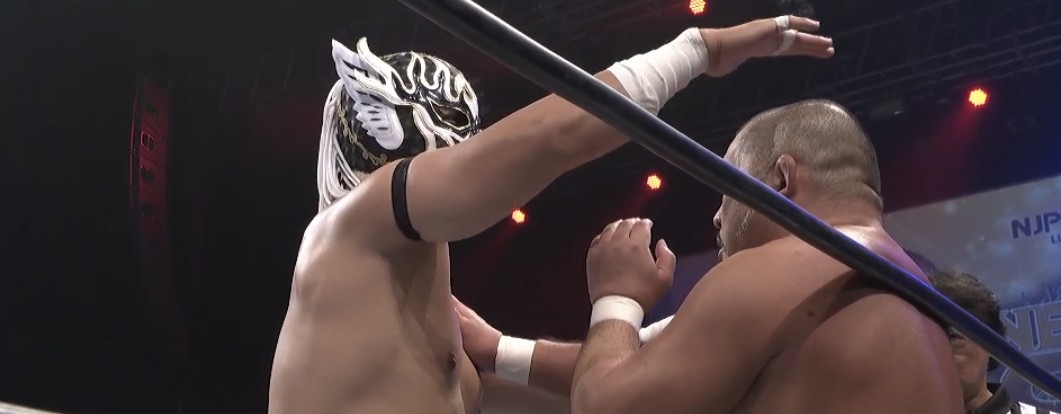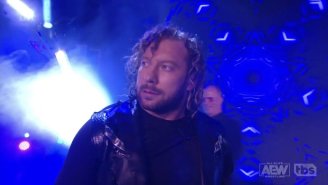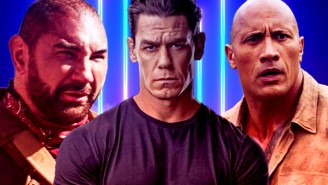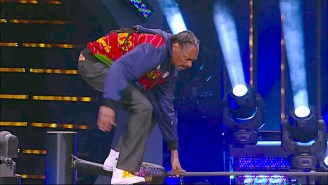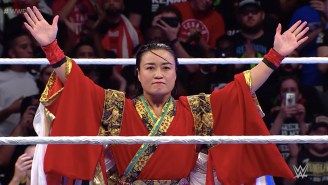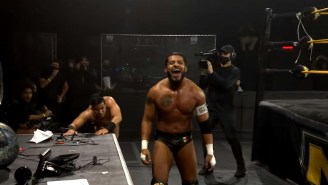Previously on NJPW: New Japan returned after over three months on hiatus! Naito showed off a new move, Uemura showed off bigger muscles, and the company showed wrestlers getting their temperature taken.
You can watch New Japan Pro Wrestling shows on their streaming service, NJPW World, which costs 999 yen (about 9 USD.)
You can keep up with With Spandex on Twitter and Facebook, follow our home site Uproxx on Twitter, and even follow me on Twitter @emilyofpratt. Don’t forget to share this column on Facebook, Twitter, or whatever social media you use, and leave a comment with your thoughts on the show and/or article. All feedback is appreciated and will help us keep up the NJPW coverage now that there’s once again NJPW to cover.
And now the Best and Worst of the first two nights of the first round of the NJPW World Special New Japan Cup, from June 16-17, 2020.
Best: HERE IN THE LAND OF THE ICE AND SNOW
🏆NEW JAPAN CUP 2020🏆が開幕🎊
第1試合は@GBH_makabe 🆚 @tsuji_njpw‼️
ヤングライオン辻が怒涛の攻撃で真壁を追い込んでいく‼️
大金星なるか⭐️⁉️#njcup #njpwworld pic.twitter.com/Sc3khY9CdN— NJPW WORLD (@njpwworld) June 16, 2020
Even before the June 16 opening match begins, it succeeds in building hype for the show through the continued miracle of Togi Makabe’s uncensored theme song. And maybe I was just riding the high of hearing a real song played on a wrestling show, but I thought Togi Makabe vs. Yota Tsuji kicked a whole lot of ass. It’s very minimal and aggressive, and especially with the body types of the wrestlers involved, it feels like a heavyweight bout from decades past. These eight minutes definitely energized me to watch more of this NJPW show, more of Makabe in this tournament, and more of Tsuji in the future.
Worst: No More Jado Matches; Society Has Progressed Past The Need For Jado Matches
🏆NEW JAPAN CUP 2020🏆が開幕🎊
第2試合は@YTR_CHAOS 🆚 @REAL_JADO‼️#BulletClub 陣営のダーティーファイトに苦しむ矢野 ‼️
この状況を打破することはできるのか⁉️#njcup #njpwworld pic.twitter.com/KXsGBXDVyT— NJPW WORLD (@njpwworld) June 16, 2020
The biggest point in the Yano vs. Jado match’s favor is that it seemed put together with the awareness that nobody really wants to see Jado wrestle in 2020. The setup from the beginning is more that Yano needs to out-cheat the three cheating members of the scaled-down Bullet Club than it is that Yano needs to beat Jado. The match is short and comedic and works around the 51-year-old not really being able to bump anymore, but it’s still not all that funny or entertaining. The top highlight: that the Master Thief’s new entrance video introduces him as “YouTuber Toru Yano.”
Worst: No More Honma Matches; Society Has Progressed Past The Need For Honma Matches
🏆NEW JAPAN CUP 2020🏆が開幕🎊
第4試合は@TIMEBOMB1105 🆚 本間朋晃‼️
IWGPジュニアヘビー級王者🆚みんなのこけし‼
一体どんな展開を見せるのか⁉️#njcup #njpwworld pic.twitter.com/Bfp6JtfIsi— NJPW WORLD (@njpwworld) June 16, 2020
While the Jado match at least seems aware of its broken-down old man’s limitations, Hiromu Takahashi vs. Tomoaki Honma attempts to press on as if they don’t exist, and the match suffers for it.
I get the kind of thing they were going for. Hiromu and Honma both made impressive recoveries from serious neck injuries at very different points in their careers; Occam’s razor says to make that dynamic the story! But while Hiromu’s comeback has so far been successful in every way and he’s still as must-watch as he was before that night in San Francisco, Honma doesn’t look like he should be wrestling. Pre-injury Honma could pull off a spirited underdog performance, but now it’s not credible that he could last twenty minutes with almost anyone on the New Japan roster and it’s not fun to watch him try. This match oscillates between being boring and concerning.
This match at least provides some quality moments of Hiromu doing Hiromu things like trying to start a slow clap with the audience at home before hitting the John Woo. His breakdown backstage over the suppressed traumatic memory of Yano shaving his head in 2011 is also amazing. Hiromu has generally been doing everything with so much mania since the comeback that I basically believe what he said backstage at the Together Project Special, that he might actually be too overwhelmed if there was an audience at these shows.
Best: Dog Eat Dog
🏆NEW JAPAN CUP 2020🏆が開幕🎊
第5試合は石井智宏 🆚 @ElDesperado5‼️
石井とデスペラードが激しいどつきあいを展開‼️#njcup #njpwworld pic.twitter.com/HbA8Q3T8BR
— NJPW WORLD (@njpwworld) June 16, 2020
Tomohiro Ishii vs. El Desperado is Despy’s first singles match in NJPW proper since he broke his jaw last spring, and he makes the most of every minute of it. The one-on-one environment highlights how distinctive his selling and body language are, and we see the full range of the character over the course of this match. He starts with the strategy he showed he was going to use in the preview tag, targeting Ishii’s knees in order to set up for Numero Dos. It’s pretty effective, but when Ishii escapes too many times, Desperado gest frustrated and starts cheating, and when Ishii fights through the cheating, Desperado is finally worked up enough to show passion as well as skill as a straight-up fighter. Ishii tends to bring that out of people, and it makes for an NJPW match formula that manages to never feel formulaic.
Worst: I’m Just A Kidd And Life Is A Nightmare
🏆NEW JAPAN CUP 2020🏆2日目‼️
第1試合は@taiji_ishimori 🆚 @GabrielKidd_‼️
石森に果敢に挑んでいくゲイブリエル・キッド‼️
金星をあげることはできるか⁉️#njcup #njpwworld pic.twitter.com/lAirEQD1bD— NJPW WORLD (@njpwworld) June 17, 2020
The June 17 show starts less strongly than the previous night with dojo newbie Gabriel Kidd vs. teacup bodybuilder and junior heavyweight legend Taiji Ishimori. Kidd doesn’t really make an impression aside from a nice brainbuster late in the game, but Ishimori’s performance is noticeably bad.
At this point in his career, there’s a big difference between when Ishimori puts on his working boots for important matches and when he just kind of shows up to work, and this match is an example of the latter. Ishimori has a famously great offensive arsenal, but his control portions here aren’t very exciting because it feels like he’s going through the motions. He even directs his acting towards a crowd that wasn’t there (aside from the sarcastic (?) chant for himself, but just some of his mannerisms), which looks robotic and is something performers have largely avoided on NJPW’s no-fans shows so far.
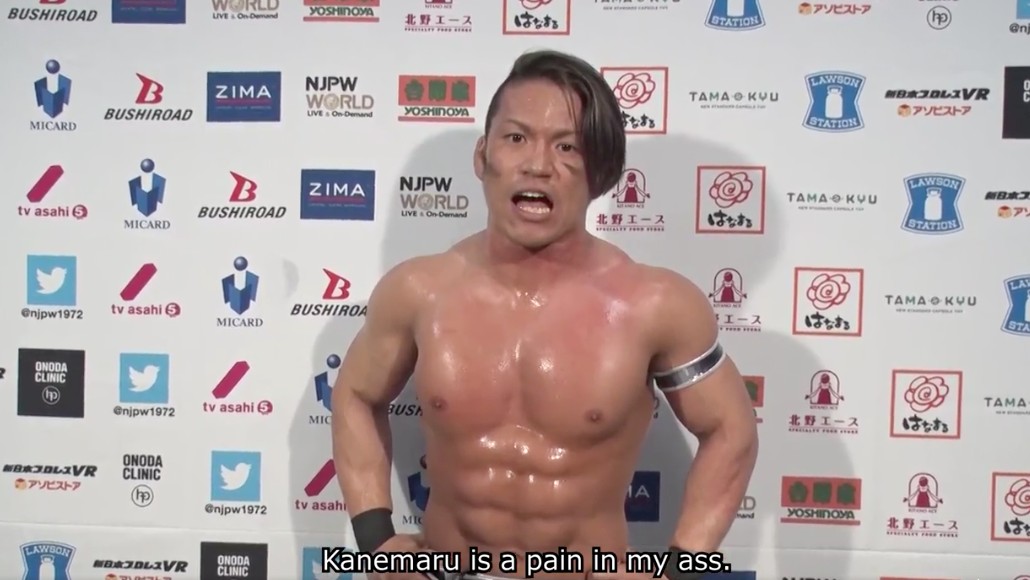
Ishimori ultimately wins, of course, and at least sells his upcoming match with Kanemaru harder with his promo than he did with the match he just wrestled, bringing up his impressively bad, years-long record against Kanemaru by saying he’s “deathly allergic” to him. I’m guessing more of Ishimori’s good qualities as a wrestler will show up during that allergic reaction.
Best: Ue-More-A
🏆NEW JAPAN CUP 2020🏆2日目‼️
第2試合は@kmaru0923 🆚 @YuyaUemura_njpw‼️
リングインする金丸を上村が奇襲‼️
怒涛の攻めで金丸を場外へと追いやっていく‼️#njcup #njpwworld pic.twitter.com/9mgcNinh0U— NJPW WORLD (@njpwworld) June 17, 2020
After the opener, it’s time for everyone to remember what Kanemaru’s theme sounds like, and for a stronger Young Lion vs. guy who made his name in Pro Wrestling NOAH match. Both wrestlers in this match show a mix of urgency and brains, which looks really impressive coming from Yuya Uemura. He didn’t spend those months in the dojo just building up muscle mass and frustration; he also came up with some quality anti-Suzukigun strategy. He jumps Kanemaru right as he gets in the ring and actually manages to avoid being whipped into the barricades at the beginning of the match. And Kanemaru doesn’t have the flashiest offense or the visual hook of having just moved up a weight class (if pro wrestling had MMA weight classes), but everything he does feels like it has a purpose and that keeps it engaging.
Uemura’s clearly moved up a few levels and now looks like he’ll be a fun guy to watch whenever they do another BOSJ, but it’s not enough for him to get the win. Kanemaru pins him with Deep Impact shortly after a sequence when he goes to hit Uemura with the whiskey bottle instead of spit whiskey at him. He’s a Heel Master, but it’s a pandemic and he’s not that evil.
Best: No Main Event For Old Men
🏆NEW JAPAN CUP 2020🏆2日目‼️
第4試合は@nagata769 🆚 @suzuki_D_minoru ‼️
7年ぶりのシングルマッチ‼️
凄まじい打撃音が響き渡る💥‼️
果たして勝つのは⁉️#njcup #njpwworld pic.twitter.com/rJ7SkbO5e5— NJPW WORLD (@njpwworld) June 17, 2020
Minoru Suzuki vs. Yuji Nagata is the highlight of the tournament so far, and a standout performance for Nagata especially. Both 52-year-olds (this took place on Suzuki’s birthday!) completely embrace this as a battle between two tough-as-nails guys who really hate each other and whose contemporaries and rivals are retiring around them. It’s not the most athletic match, but it’s incredibly motivated. There’s no wasted action; you really feel like both Nagata and Suzuki are doing everything they’re doing for a reason.
Something that stands out about Nagata in this match is how much his former top guy qualities, the ones that never really go away if a performer doesn’t completely let them go, come to the surface. Aside from Nagata’s kicks and exploders still looking amazing, he dusts off the big match protagonist version of himself. The way he plays Suzuki trapping him in the corner is fantastic, like he sees there’s no escape and just decides to grit his teeth through getting forearmed in the face. It works really well as a contrast to Suzuki’s brand of toughness, which is rooted in a hedonism about the whole act of pro wrestling.
Nagata’s extremely doomed against Okada, but this match reminds everyone of all the reasons to root for him beforehand (and maybe check out some of his older matches in the meantime.)
Gedo’s Revenge
🏆NEW JAPAN CUP 2020🏆2日目‼️
第5試合は@rainmakerXokada 🆚 外道‼️
練習中に腕を負傷したと言う外道‼️
このまま試合をすると言うが、果たして本当なのか⁉️#njcup #njpwworld pic.twitter.com/OLH77N3JEC— NJPW WORLD (@njpwworld) June 17, 2020
Our actual main event is a weird one: a Gedo vs. Kazuchika Okada match packed with all the shenanigans they could think of. The sheer amount of illegal activity is probably the match’s biggest strength because otherwise it would be even less believable that Gedo could last fifteen minutes with the guy who used to be the untouchable golden god of this promotion.
The two easiest answers for why Gedo was able to last so long are 1) maybe they needed the show to go at least two hours, and 2) he is the booker of New Japan Pro Wrestling. When the easiest ways to explain what’s happening on a wrestling show are the smarky meta ones, you know the show is doing something wrong. Some of Gedo’s offensive success does make sense in kayfabe though because 1) he used to be Okada’s manager and should know everything about the Rainmaker as a wrestler, and 2) some of his weapon attacks are with objects that should hurt a lot! I’ll buy Okada continuing to sell being attacked with a spanner and then kicked in the belly many times for a while. It would be very hard to do cardio after that.
The match’s opening with Okada being ready for the tricks of Gedo’s he’d seen before, then being waylaid by Gedo’s backup tricks was fun and well-executed. But overall, this match just strains believability too much by asking the audience to believe that the Okada character would have this much trouble with a much smaller, 51-year-old man who wrestles about two singles matches a year, has been more relevant as a manager than a wrestler for a while now, and is known by many to be a powerful backstage figure.
Best: Next Time On New Japan Pro Wrestling
🏆NEW JAPAN CUP 2020🏆が開幕🎊
第3試合は🏆NEW JAPAN CUP 2020🏆の前哨戦‼️
本隊 🆚 #鈴木軍‼️鈴木軍陣営が@tanahashi1_100の膝を集中攻撃💥‼️
このまま膝を破壊されてしまうのか⁉️#njcup #njpwworld pic.twitter.com/UEu1goxExB— NJPW WORLD (@njpwworld) June 16, 2020
The tag matches previewing future singles matches are usually the most skippable parts of New Japan shows, but the eight-man tags in the middle of both of these shows are highlights, with everyone involved bringing the physical and dramatic intensity of wrestlers working hard to sell their next bout and make up for not being able to wrestle for months.
I’d say the stronger one in terms of both action and drama is the Suzuki, Taichi, ZSJ, and Kanemaru vs. Tanahashi, Ibushi, Nagata, and Uemura match from June 16, which makes everyone and every upcoming match look good, but especially the two we still haven’t seen yet: Ibushi vs. Sabre and Tanahashi vs. Taichi. Some Dangerous Tekkers tag teamwork is a reminder that oh yeah, they are a legitimate tag team now and this feud is really about the tag titles, and we get to see Ibushi enter the ring with Kill Bill sirens already fully blaring in his brain.
This feud and its internal singles feuds have also been elevated by some of the best backstage promos of the tournament so far, especially from the bad guys. Both teams make sure to talk about both the tag titles and the tournament, and everyone is confident they’re going to wrestle their partner in the second round. Taichi goes extra hard on the mic, insulting all of NJPW’s foreign wrestlers who aren’t Zack (unlike his partner, they weren’t courageous and professional enough to stay in Japan), on Tanahashi’s quarantine weight (Taichi only gained weight to keep up with him), and on the whole concept of love. ZSJ’s main points are how hot Ibushi is and how he beats him every year in the New Japan Cup; these are also quality promo material. As much as I love Golden Ace, I think I’m more pro-Dangerous Tekkers as tag champions just because I want them to keep cutting promos together.
🏆NEW JAPAN CUP 2020🏆2日目‼️
第3試合 #CHAOS 🆚 #LIJ‼️#njcup 一回戦で闘う@njpwShowTと@Takagi__Shingoがリング上で激しいどつきあいを展開‼️#njcup #njpwworld pic.twitter.com/Yen2P6x4In
— NJPW WORLD (@njpwworld) June 17, 2020
The Chaos (Goto, Yoshi-Hashi, Yoh, and Sho) vs. L.I.J. (Evil, Sanada, Bushi, and Shingo) match the next night stands out less as a tag match, but does a good job of hyping up Sho vs. Takagi II. Sho is very focused on Shingo from the beginning while Shingo tries to play things a little cooler, but when they’re actually wrestling, both are convincingly invested and continue to work well together. Also, Sho’s hair is clearly Like This now so he can do intense emo stares at his arch-rival from underneath it.
The standout promos from NJPW’s no-fans shows so far that aren’t from Hiromu or Dangerous Tekkers come from the Sho-Shingo rivalry, definitely helped by having the most to talk about. Backstage at the comeback show, Sho played things as if his match with Shingo is happening as a natural step in their rivalry, saying “You told me that you’d wait for me to reach you.” Without even hearing this first, Shingo completely rebuts it by saying he doesn’t see any change in Sho since the last time they faced off, and point out that he just got this match by luck. On the 17th, Shingo admits he was wrong and that Sho has improved a little, but Sho acknowledges that Shingo was right; he did get this match by luck and he needs more than luck to win.
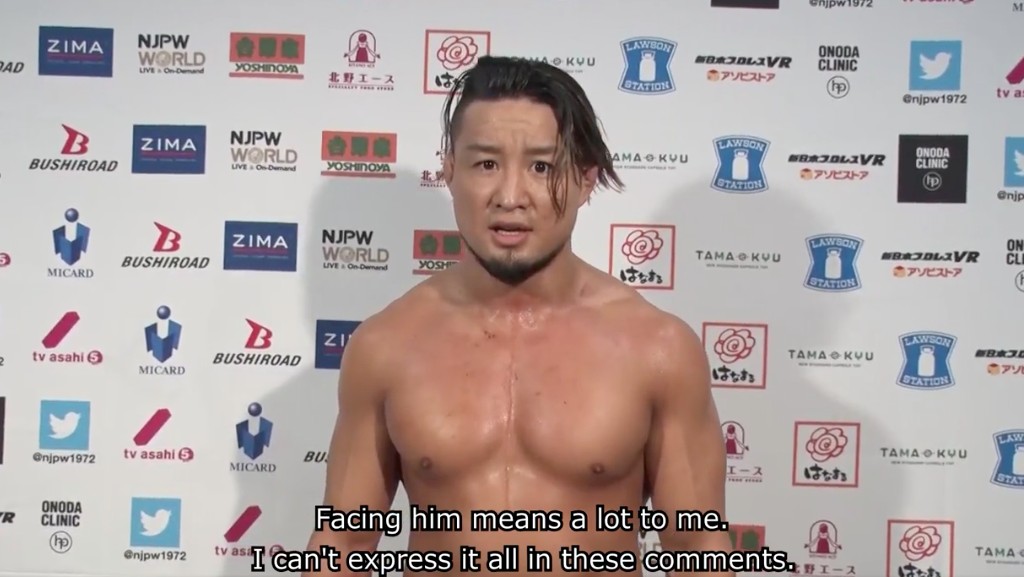
An interesting thing about their dynamic is that it’s not really face vs. heel. Takagi’s pretty harsh with Sho, but he’s also been rooting for him, in his own way, since their singles match last year. Shingo seems to actually want Sho to step up; he’s not just bragging about being on a higher level in order to keep Sho down. And though getting in the ring with Takagi sends Sho from zero to rage mode in about three seconds, he also clearly respects him and never acts like he needs to defeat him out of revenge or moral obligation. It’s something he now needs to do, even more than he needed to heading into BOSJ last year, in order to show he’s reached another level as a wrestler.
All this points, I think, to Sho losing next week and to these characters continuing to be linked together past this tournament. You can point to the New Japan Cup bracket and think about how NJPW was starting to re-heat this rivalry earlier this year but didn’t originally make it part of this tournament as evidence of this, but it also makes sense in kayfabe as the natural next step in the story. Takagi seems like he has the right balance of focus on this rivalry and this match while also looking forward to the rest of the tournament, facing other people in L.I.J., and eventually facing Naito. Meanwhile, Sho seems focused only on this match as a personal and professional accomplishment, but he doesn’t sound all that confident about it, or like the wrestler he needs to be in order to break out in his career.
To get back on a meta-level, if this angle keeps going as well as it has been, when Sho does actually get this win, it should be really compelling as a match, a dramatic climax, and the crowning of an up-and-coming star, and that’s the kind of moment that really needs an audience. It deserves the soundtrack and the palpable emotional investment of all the women who make Roppongi 3K signs – and the rest of the NJPW fandom whose glue gun skills I haven’t had the opportunity to judge. This doesn’t make me any less excited to see Sho and Shingo clothesline the baby oil off of each other on Monday; it just also makes me look forward to match number three at some point in the future. (Unless I’m completely wrong and Sho wins! In which case, good for him, but kind of a weird choice for a no-fans show!)
And on the no-fans aspect of these shows, I think that the first two installments of the New Japan Cup didn’t do as good of a job of consistently filling the empty atmosphere as the Together Project Special, but they were still always really easy to watch. Some matches were much better than others, but overall, the shows both were only two hours of almost entirely wrestling that featured very different lineups each day of people who haven’t wrestled on TV in a while. NJPW has so far made it very easy to just tune into these and see how they go.
I’ll see you back here next week after we see how more of these go with a Best and Worst breakdown of Dangerous Tekkers vs. Golden Ace, Sho vs. Shingo, and the rest of the first round of the right side of the bracket.

